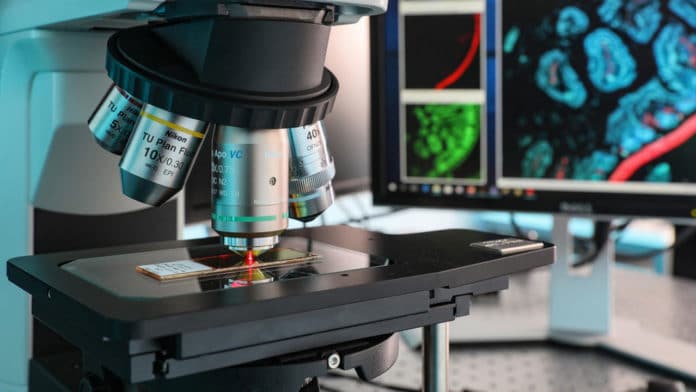Fluorescence microscopy works by detecting the light that compounds called fluorophores transmit when energized. All the more explicitly, fluorophores retain light at a given wavelength, called the excitation wavelength, and, accordingly, emit light at a longer wavelength, called the emission wavelength.
With fluorescence microscopes, scientists can see objects that are normally fluorescent or that have been marked with a fluorophore, and that would be difficult to see with a regular microscope.
But there are two main drawbacks to using glass slides in fluorescence microscopy. First, fluorophores usually emit a very small amount of light. And second, most of the view that they do emit gets lost in the slide, meaning it can’t be used. As a result, many compounds are hard or even impossible to detect unless there is a relatively large amount in the sample.
Scientists at EPFL’s School of Engineering stands to break with tradition. They have developed a novel type of glass slide with a coating that “structures” light-emitting up to 25 times more light and thereby enhancing the sensitivity of the microscopes they are used with.
The slides are developed explicitly for fluorescence microscopy. Their design has unique optical properties, and it allows the detection of a minute amount of light.
According to scientists, this could be especially useful for making an early-stage diagnosis, quickly identifying specific types of cancer, and rapidly archiving pathology samples.
Nicolas Descharmes from the Institute of Microengineering in Neuchâtel, part of EPFL’s School of Engineering, said, “In an ideal case, our slides could be used to detect the presence of one molecule, where 25 molecules would be needed on conventional slides.”
These new slides have a layered structure that can control the electromagnetic environment surrounding the samples. When they are exposed to light, they emit more light than they would on a conventional slide, and all of that light is directed towards the microscope’s detector. That results in images that are clearer or that can be generated more quickly.
Séverine Lorrain, a senior technician at UNIL’s Protein Analysis Facility who works on detecting proteins in samples, said, “What I’ve seen so far is highly promising. I was impressed by how efficient the slides are in amplifying the fluorescence signal. That means I could avoid going through a separate signal amplification step – a big advantage since that step often introduces background noise.”
Jessica Dessimoz, head of the EPFL Histology Core Facility, also finds the new slides promising: “The surface of these slides improves the visualization of the fluorescent signal and reduces the exposure time required. It could prove very useful for applications like cyclic immunofluorescence.”
Raphaël Barbey, also from the Institute of Microengineering in Neuchâtel, said, “Scanning conventional slides in fluorescence takes a long time because the signals are weak. But with our slides, the process could go a lot faster. The hard part will be convincing researchers to give up some of their old slides!”
“The advantage of our approach is that it entails a minor change for microscope users but could substantially improve their instruments’ performance.”
The scientists have patented their technology, and their slides – which have already been used by researchers in a range of fields – will soon be tested at several companies. The pair has received the support from EPFL, the Gebert Rüf foundation and Innosuisse, and plans to launch their own company in the coming months. Through their startup, Descharmes and Barbey will be able to scale up production and make the slides available to hospital labs and diagnostics providers.
